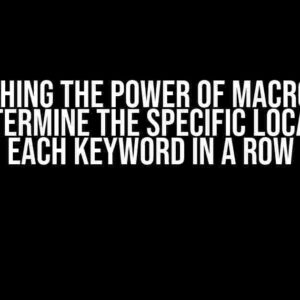Have you ever been in a situation where you needed to paste a string of text into a cell with carriage returns, only to find that it overwrites the values below? It’s frustrating, to say the least. But fear not, dear reader, for today we’re going to tackle this common problem head-on and provide you with a comprehensive guide on how to prevent a paste in a cell with carriage returns from overwriting the values below.
Understanding the Problem
Before we dive into the solution, let’s take a step back and understand why this issue occurs in the first place. When you copy a string of text with carriage returns (also known as line breaks), it’s stored in the clipboard as a single string. When you paste it into a cell, Excel treats it as a single value and applies it to the entire cell range, resulting in the overwrite.
The Culprits: Carriage Returns and Line Breaks
Carriage returns (CR) and line breaks (LF) are special characters used to indicate a new line in a string of text. In Windows, the default is to use both CR and LF characters together (CRLF) to create a new line. However, when you copy and paste text, these characters can get lost in translation, causing the paste operation to misbehave.
Solutions Galore!
Fear not, dear reader, for we have not one, not two, but three solutions to this problem! Each solution has its own strengths and weaknesses, which we’ll explore in detail below.
Solution 1: Using the Transpose Function
The first solution involves using the TRANSPOSE function in combination with the PASTE SPECIAL function. This method is useful when you need to paste a single column of data with carriage returns.
=TRANSPOSE(SPLIT(A1,CHAR(10)))
In this formula, we’re using the SPLIT function to separate the string into an array, using the CHAR(10) function to specify the line break character. The TRANSPOSE function then converts the array into a column of values.
Solution 2: Using Text to Columns
The second solution involves using the Text to Columns feature in Excel. This method is useful when you need to paste a large dataset with carriage returns.
Follow these steps:
- Select the cell range where you want to paste the data.
- Go to the Data tab > Text to Columns.
- Choose Delimited Text and click Next.
- Select the “Other” delimiter and enter the line break character ( Alt + 010).
- Click Finish.
Once you’ve set up the Text to Columns feature, you can paste the data into the cell range, and Excel will automatically split the string into separate columns.
Solution 3: Using VBA Macro
The third solution involves using a VBA macro to parse the string and paste it into the cell range. This method is useful when you need to automate the process or perform complex operations on the data.
Sub PasteWithCarriageReturns()
Dim strText As String
Dim arrText As Variant
Dim i As Long
strText = Clipboard.GetData(vbCFText)
arrText = Split(strText, vbCrLf)
For i = 0 To UBound(arrText)
Range("A" & i + 1).Value = arrText(i)
Next i
End Sub
In this macro, we’re using the Clipboard object to retrieve the copied text, and then splitting it into an array using the vbCrLf constant. We then loop through the array and paste each element into the corresponding cell.
Tips and Variations
Now that we’ve covered the three main solutions, let’s explore some tips and variations to help you overcome common obstacles.
TIP 1: Using the Paste Special Values Option
When using the Paste Special function, make sure to select the Values option to prevent formatting from being applied.
| Paste Special Dialog Box |
 |
TIP 2: Handling Unicode Characters
If you’re working with Unicode characters, make sure to use the correct encoding when pasting the data.
Range("A1").Value = StrConv(Clipboard.GetData(vbCFUnicodeText), vbFromUnicode)
VARIATION 1: Pasting into a Table
If you need to paste data into a table, you can use the following formula:
=TRANSPOSE(SPLIT(A1,CHAR(10)))
This formula will paste the data into a table format, with each new line becoming a new row.
VARIATION 2: Pasting into a Range with Multiple Columns
If you need to paste data into a range with multiple columns, you can modify the SOLUTION 1 formula to accommodate multiple columns.
=TRANSPOSE(SPLIT(A1,CHAR(10)))
Simply adjust the range to include the additional columns, and the formula will paste the data accordingly.
Conclusion
And there you have it, folks! With these three solutions and tips, you should be able to prevent a paste in a cell with carriage returns from overwriting the values below. Remember to choose the solution that best fits your needs and adjust accordingly. Happy pasting!
KEY TAKEAWAYS:
- Use the TRANSPOSE function to paste a single column of data with carriage returns.
- Use the Text to Columns feature to paste a large dataset with carriage returns.
- Use a VBA macro to automate the process and perform complex operations on the data.
- Use the Paste Special Values option to prevent formatting from being applied.
- Handle Unicode characters by using the correct encoding when pasting the data.
COMMON MISTAKES TO AVOID:
- Not using the correct delimiter when using the Text to Columns feature.
- Not adjusting the range when using the TRANSPOSE function.
- Not handling Unicode characters correctly.
RESOURCES:
- Microsoft Excel Help: TRANSPOSE function
- Microsoft Excel Help: Text to Columns feature
- Excel Is Fun: Pasting multiple columns with carriage returns
Frequently Asked Question
Mastering the art of keeping those pesky paste-in cells with carriage returns in check!
Q1: What’s the deal with paste-in cells and carriage returns, anyway?
When you copy and paste a cell with carriage returns into another cell, it can overwrite the values below because the carriage returns are treated as new lines. This can be super frustrating, especially if you’re working with large datasets!
Q2: Is there a way to prevent this from happening in the first place?
Yes! You can use the “Transpose” function (Ctrl+Shift+’) before pasting the values. This will convert the carriage returns into commas, preventing them from overwriting the values below.
Q3: What if I forgot to transpose and the damage is already done?
No worries! You can use the “Text to Columns” feature (Data > Text to Columns) to split the pasted values into separate columns. This will help you recover the overwritten values.
Q4: Are there any other ways to prevent overwriting values when pasting cells with carriage returns?
Another approach is to use the “Paste Special” feature (Ctrl+Alt+V) and select “Values” only. This will paste the values without the formatting, which includes the carriage returns.
Q5: Can I prevent this issue altogether by adjusting some settings?
Yes! You can adjust the default paste behavior in Excel by going to File > Options > Advanced and checking the box next to “Use the Insert key to control the overwrite mode”. This will prevent overwriting values when pasting cells with carriage returns.


